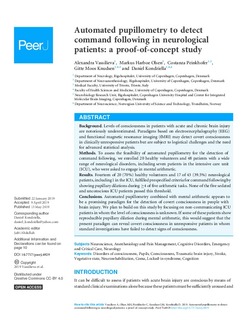| dc.contributor.author | Vassilieva, Alexandra | |
| dc.contributor.author | Olsen, Markus Harboe | |
| dc.contributor.author | Peinkhofer, Costanza | |
| dc.contributor.author | Knudsen, Gitte M | |
| dc.contributor.author | Kondziella, Daniel | |
| dc.date.accessioned | 2020-02-17T14:42:41Z | |
| dc.date.available | 2020-02-17T14:42:41Z | |
| dc.date.created | 2019-11-19T15:30:52Z | |
| dc.date.issued | 2019 | |
| dc.identifier.citation | PeerJ. 2019, 2019 (5), 1-14. | nb_NO |
| dc.identifier.issn | 2167-8359 | |
| dc.identifier.uri | http://hdl.handle.net/11250/2642066 | |
| dc.description.abstract | Background
Levels of consciousness in patients with acute and chronic brain injury are notoriously underestimated. Paradigms based on electroencephalography (EEG) and functional magnetic resonance imaging (fMRI) may detect covert consciousness in clinically unresponsive patients but are subject to logistical challenges and the need for advanced statistical analysis.
Methods
To assess the feasibility of automated pupillometry for the detection of command following, we enrolled 20 healthy volunteers and 48 patients with a wide range of neurological disorders, including seven patients in the intensive care unit (ICU), who were asked to engage in mental arithmetic.
Results
Fourteen of 20 (70%) healthy volunteers and 17 of 43 (39.5%) neurological patients, including 1 in the ICU, fulfilled prespecified criteria for command following by showing pupillary dilations during ≥4 of five arithmetic tasks. None of the five sedated and unconscious ICU patients passed this threshold.
Conclusions
Automated pupillometry combined with mental arithmetic appears to be a promising paradigm for the detection of covert consciousness in people with brain injury. We plan to build on this study by focusing on non-communicating ICU patients in whom the level of consciousness is unknown. If some of these patients show reproducible pupillary dilation during mental arithmetic, this would suggest that the present paradigm can reveal covert consciousness in unresponsive patients in whom standard investigations have failed to detect signs of consciousness. | nb_NO |
| dc.language.iso | eng | nb_NO |
| dc.publisher | PeerJ | nb_NO |
| dc.rights | Navngivelse 4.0 Internasjonal | * |
| dc.rights.uri | http://creativecommons.org/licenses/by/4.0/deed.no | * |
| dc.title | Automated pupillometry to detect command following in neurological patients: a proof-of-concept study | nb_NO |
| dc.type | Journal article | nb_NO |
| dc.type | Peer reviewed | nb_NO |
| dc.description.version | publishedVersion | nb_NO |
| dc.source.pagenumber | 1-14 | nb_NO |
| dc.source.volume | 2019 | nb_NO |
| dc.source.journal | PeerJ | nb_NO |
| dc.source.issue | 5 | nb_NO |
| dc.identifier.doi | 10.7717/peerj.6929 | |
| dc.identifier.cristin | 1749549 | |
| dc.description.localcode | Open Access article. Copyright 2019 Vassilieva et al. Distributed under Creative Commons CC-BY 4.0 | nb_NO |
| cristin.unitcode | 194,65,35,0 | |
| cristin.unitname | Institutt for psykisk helse | |
| cristin.ispublished | true | |
| cristin.fulltext | original | |
| cristin.qualitycode | 1 | |

